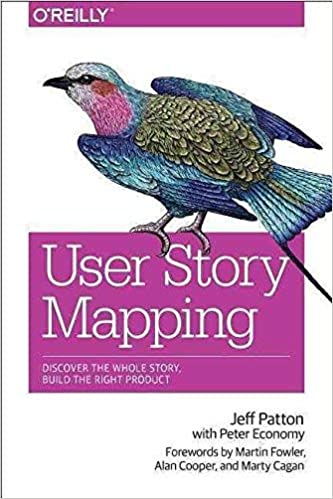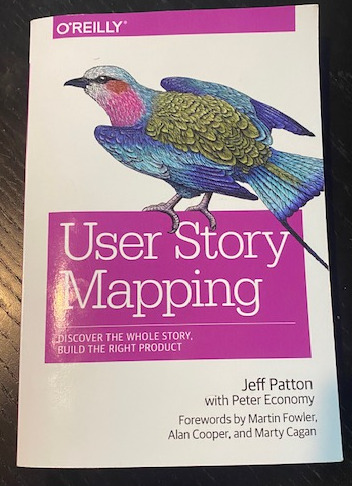User Story Mapping
Discover the whole story, build the right product
User story mapping is a valuable tool for software development, once you understand why and how to use it. This insightful book examines how this often misunderstood technique can help your team stay focused on users and their needs without getting lost in the enthusiasm for individual product features.
In my opinion, one of the most under rated skills on any software project, is the ability to write effective user stories and the abilities to prioritise and schedule wok effectively. I have witnessed organisations failing and even occasionally succeeding at this at varying degrees. In most cases, development teams usually complain about the quality of the stories or tasks with either too much or even too little information available in the stories to help them effectively complete their tasks.
All software developers will inevitably encounter two of the most difficult things in software development
- Naming things is difficult
- Estimating tasks is extremely difficult
Over past year of so I have been involved in a number of projects across a number of different organisations and one of the recurring themes across them all, was that the developers and QA all had a hard time of making sense of the User Stories.
Why I read this book
I have being engaged on more senior roles on a number of projects and also a number of my side projects are progressing to stages where more developers are actively contributing, therefore being able to effectively communicate what is required in tasks and plan work has been a recurring theme over the past year or so.
I've never really had any training or even had any prior knowledge on how to write effective user stories, yet I find myself having to write them more frequently! I thought it may be a good time to actually get some grounding on the subject.
I recalled while reading Inspired: How to Create Tech Products Customers Love that Marty Cagan mentioned in Chapter 38, Story Map technique, how leading Agile Thinker Jeff Patton had also been frustrated by this and had devised a process of Story Mapping, he had also provided a link to the book for reference.
In fact, I think Marty Cagan summerisation of User Story Mapping and how it is a great technique for framing and planning, ideation, communicating with stakeholders and managing and organising work. He also stated there was a clear difference between a backlog of user stories and story mapping.
Inspired
How to Create Tech Products Customers Love
How do today's most successful tech companies-Amazon, Google, Facebook, Netflix, Tesla-design, develop, and deploy the products that have earned the love of literally billions of people around the world?
Why I like this book
The thing that really stands out to me about this book, is just how easy it was to read. Then also because of this, just how interesting it is, coupled with the fact how informative and just how easy it is to actually get some value out of it.
I have to admit, at first I really started to listen to the audio book version, while out walking the dog but after a few chapters bought the book because I found myself quite absorbed the subject , and was taking far too many notes while out! Over the past few months, this book has not left my desk as I continue to try refine and implement what I am learning from this book.
One expectation that I feel readers to manage about this book, is that it's not a really one time read and its done book, but rather it is hand-book you reach for again and again to remind yourself of the basic principles relating to product management.
What I learned from this book
The biggest take away you'll get from this book, is that most "Agile" tools like Jira etc are mostly completely useless and in many ways cause more problems.
Another massive take away is that there is no perfect way to write user stories and irrespective of what most "Agile Coaches" say, there isn't really a need to write stories in an explicit way like using a Given When Then type syntax, mostly because this just actually leads to poorly understandable stories. What is of primary importance in all stories is that the needs, intended outcomes and value of the story are clearly expressed and can be understood.
This is probably one salient points about this book, is that despite it's title it is not a manual on how to write user stories but it is rather a broad compendium of knowledge about software product management.
The book contains several hints, useful tips and checklists to assist with your product management:
- Steps how to build a big picture
- Six simple steps for story mapping
- A checklist of what to talk about during the conversation
- Plan to build less
- Plan to build on time
- Plan to learn faster
User story mapping is not about creating a set of written requirements, but a way of thinking. Telling stories through words and pictures builds understanding and helps solve problems for organisations, customers, and users.
It important that as software developers we understand what users are trying to achieve and should collaborate in building the stories that capture their needs.
Why I recommend this book
It may be a bit cliche to say this, but this is a book of two halves. The first half is more of a collections of stories, anecdotes and examples of how to use user stories and the second discusses user story mapping in the context of the discovery process, product backlog, backlog refinement, design thinking, product review, product release and retrospective.
In my opinion this book is provides a great background on story mapping and its applications, benefits, and pitfalls. Presenting numerous ideas that help to bridge the gaps between designers, developers, and business representatives and build shared understanding.
The book covers the complete product life-cycle—from concept to delivery and is a must read for everyone working in agile or Lean development, as well as those who are just starting to explore these approaches. I believe this book would be immensely helpful to all teams trying to apply user story mapping in their work, and I highly recommend the book to anyone working in product development.
That being said the last few chapters, did feel a little heavy reading at times, and no doubt I will be returning to them as time goes on.
User Story Mapping
Discover the whole story, build the right product
Understand how stories really work and how they come to life in Agile and Lean projects
- What is this Directory.Packages.props file all about? - January 25, 2024
- How to add Tailwind CSS to Blazor website - November 20, 2023
- How to deploy a Blazor site to Netlify - November 17, 2023


